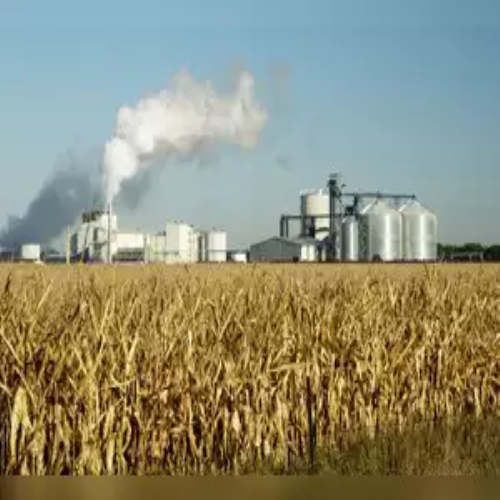Agriculture and biofuel industries react to new rules for sustainable aviation fuel tax credit

The U.S. Treasury issues guidelines for sustainable farming practices to reduce corn-based ethanol and soybean oil’s carbon intensity for aviation fuel production. The updated GREET model determines carbon intensity, with a 50% reduction earning $1.25 per gallon. Ethanol and soybean oil producers can qualify for tax credits by implementing climate-smart agricultural practices. Industry reactions express both optimism and concerns over practicality and flexibility in meeting emission reduction goals.
Today the U.S. Department of Treasury released guidance on how sustainable farming practices can contribute to lowering the carbon intensity of corn-based ethanol and soybean oil used for sustainable aviation fuel production.
SAF production tax credit guidance
This afternoon the department released an updated version of the GREET model that can be used to demonstrate the carbon intensity (CI) of sustainable aviation fuel (SAF) under the 40B SAF tax credit.
Qualifying SAF must demonstrate a 50% CI reduction to earn $1.25 a gallon. For every percentage point higher the SAF can achieve through a qualify greenhouse gas model, like GREET, the producer can earn an additional penny, up to $1.75.
Counting farm practices
SAF can be produced from a variety of feedstocks, including ethanol and soybean oil. Included in the announcement is a pilot program for accounting for sustainable farming practices in the CI calculation for those two feedstocks.
Corn-based ethanol
For corn-based ethanol, Treasury says corn produced using “no-till, cover crop, and enhanced efficiency fertilizer” will qualify for a greenhouse gas reduction under the pilot program.
Soybean oil
Soybean oil from soybeans grown using cover crops and no-till will receive a reduction.
Industry stakeholders react
Industry leaders appear excited about the pilot program while also calling for more flexibility. Several reactions also focused on building on today’s announcement for the 45Z Clean Fuel Production tax credit.
The 40B SAF tax credit expires at the end of this year. The 45Z Clean Fuel Production tax credit starts next year and will include SAF. In the announcement today the Treasury Department said another GREET update would be made specifically for 45Z.
Renewable Fuels Association
“We are encouraged that, for the first time ever, this carbon scoring framework will recognize and credit certain climate-smart agricultural practices,” says Geoff Cooper, CEO of the Renewable Fuels Association (RFA). “We’re also pleased to see the integration of other carbon reduction strategies—like renewable process energy and carbon capture and sequestration—into the model. However, RFA believes less prescription on ag practices, more flexibility, and additional low-carbon technologies and practices should be added to the modeling framework to better reflect the innovation occurring throughout the supply chain.”
Cooper continues, “We view today’s 40B announcement as the starting point — not the ending point — for additional modeling improvements, further integration of individual climate-smart agriculture practices, and emerging biorefinery technologies. 45Z is where the rubber really meets the road. We look forward to working with USDA and other agencies across the administration to ensure 45Z is implemented in a way that truly swings the door wide open for farmers and ethanol producers to participate in the enormous decarbonization opportunity.”
Growth Energy
“This guidance crosses an important threshold in carbon modeling, recognizing for the first time that farming techniques can reduce the carbon intensity of crops, and, by extension, bioethanol production,” says Emily Skor, CEO of Growth Energy. “It’s also the first time Treasury has used the Argonne National Laboratory’s GREET model in federal tax policy. These are promising big-picture developments and signal that agriculture is a key part of our nation’s climate strategy.
“… Still, the administration’s restrictive all-or-nothing approach to recognizing the value of climate-smart agriculture practices may ultimately limit innovation and make farmers, blenders, and producers less – not more – likely to invest in emissions-reducing technologies.”
American Soybean Association
“For growers like me here in North Dakota, short growing seasons and unpredictable fall weather make the cover crop requirement alone next to impossible,” says Josh Gackle, president of the American Soybean Association. “Growers in the Northern Plains do so when possible. However, employing both no till and cover cropping is contrary to what Mother Nature will allow, no matter what the guidance specifies.”
American Coalition for Ethanol
“While today’s announcement is a step in the right direction, ethanol-to-jet continues to face headwinds such as artificially inflated land use change penalties in 40B GREET and the initial all-or-none requirement to bundle three CSA [climate-smart agriculture] practices in order to produce qualifying corn ethanol feedstock for SAF,” says Brian Jennings, CEO of the American Coalition for Ethanol.
“With the 2024 planting season underway and the expiration of the 40B credit on December 31, 2024, Treasury’s SAF guidance speaks more to the administration codifying the important role CSA practices play in decarbonizing liquid fuels than the amount of ethanol-to-jet that will qualify for the 40B credit.”
Iowa Renewable Fuels Association
“We appreciate the Treasury Department for approving the use of the GREET model, and for USDA pushing to get farm practices included for the first time,” says the Iowa Renewable Fuels Association Executive Director Monte Shaw. “Those are landmark achievements that crack the door open for farmers to be rewarded for climate-smart agriculture practices. Having said that, today’s announcement also makes clear that a great deal of work remains to transition 40B to the new 45Z tax credit in 2025.”
Shaw adds, “The approved bundle of farm practices won’t work for many Iowa farmers, let alone farmers throughout the Midwest. Given the range of climates and soil types, farmers do not want one-size-fits-all bundles mandated from D.C.”
Clean Fuels Alliance America
“Clean Fuels and its members appreciate the significant work of USDA and other federal agencies to account for the role that U.S. farmers will play in decarbonizing the nation’s aviation fuel,” says Kurt Kovarik, vice president of federal affairs for Clean Fuels Alliance America. “U.S. farmers and SAF producers will continue to work with the agencies to rapidly expand SAF production over the next few years.”
Kovarik adds, “Biodiesel, renewable diesel, and SAF producers are already negotiating feedstock and fuel offtake contracts for 2025, so we look forward to working with Treasury and USDA to quickly turn attention to guidance for the Clean Fuel Production Credit that begins on January 1 next year. We believe there are additional climate-smart agriculture practices and industry data that can be incorporated in the GREET model to support the continued sustainable growth of the entire clean fuel industry.”
American Carbon Alliance
“The GREET model is the absolute gold standard when it comes to evaluating the environmental impacts of fuels,” says Tom Buis, CEO of the American Carbon Alliance. “It is an important first step for our industry that for the first time, the U.S. Treasury has used the GREET model in federal tax policy.
“Today’s guidance recognizes the pivotal role that corn ethanol can play as the feedstock for sustainable aviation fuels. This is a good first step. We look forward to improvements that are forthcoming, as Treasury develops guidance for the 45Z provisions, as outlined by Secretary Vilsack.”
Iowa Department of Agriculture and Land Stewardship
“As the top producing state of lower cost and cleaner burning biofuels, sustainable aviation fuel is an emerging market with huge potential for Iowa agriculture,” says Iowa Secretary of Agriculture Mike Naig.
Unfortunately, the Biden administration is once again telling Iowa farmers that Washington D.C. knows best. The administration’s proposal mandates rigid requirements that ignore the innovation of agriculture and fails to recognize farmers ability to incorporate the practices that work best for their individual operations. This administration has continually pursued a one-size-fits-all approach that puts domestic energy production, like homegrown ethanol, at a disadvantage to international competitors. Yesterday’s guidance is more of the same.
While inclusion of the GREET model is a welcome step, the details need to be right, and the administration has more work to do. I know Iowa’s Congressional delegation will be working to ensure that Iowa’s farmers and biofuel producers will be able to realize the full potential that SAF offers.”
Iowa Corn
“While it is positive to see for the first time ever climate smart farming practices included in this guidance, the fact that these practices are not inclusive of what most farmers are doing combined with the requirement the practices that are included must be bundled will exclude most corn from eligibility for this credit,” said Jolene Riessen, Iowa Corn Growers Association President, and a farmer from Ida Grove. “It will be imperative under the 45Z ethanol production credit that takes effect January 1, 2025, to be more expansive across all types of farming practices and allow a grower to not have to bundle to truly allow corn to have access to the Sustainable Aviation Fuel market.”
National Corn Growers Association
“We are deeply disappointed that this updated model requires farmers to implement environmental practices that are not practical for all acres of the large and varied geographic region in which corn is grown. This requirement in GREET will significantly hinder the chances corn growers have in accessing the sustainable aviation fuel market, even as higher blends of corn ethanol offer great promise in the country’s fight against greenhouse gas emissions and climate change. … As corn growers, we already understand the environmental practices that work best for our growing conditions and climate, so it is not necessary for the government to dictate specifically how we reach an emissions reduction goal. Farmers are going to have different methods depending on a variety of factors, including where their farms are located.”
National Oilseed Processors Association
“Acknowledging, for the first time, the carbon benefits that climate-smart agriculture practices can deliver is a significant step to ramping up SAF production and NOPA is pleased to see the updated GREET model recognize the positive environmental impact of U.S.-produced biofuels.
“However, we are concerned the requirement to implement climate-smart ag practices simultaneously will limit this opportunity, particularly in parts of the country where it may not be possible to plant a cover crop or the cost to implement new practices is too steep. We look forward to further reviewing today’s announcement and having a continued dialogue with the administration to better understand what this and other provisions, including indirect land use change impact, mean for the industry and how we can competitively and efficiently meet the needs of the SAF market.
“Since 2021, NOPA members have made over $6 billion in investments supporting a 1-billion-gallon increase in capacity while reducing the soybean supply chain carbon footprint by 19%. This was made possible through improved soil health and water quality, decreased chemical application, implementation of no till practices, expansion of cover crops, and transitions from coal to natural gas fuel sources- all while improving yields.
“These direct examples reiterate that the oilseed industry stands ready to work alongside the Biden Administration and the airline industry on the expanded use and production of U.S. farmer grown biofuels to drive innovation, cut aviation emissions, and create U.S. jobs,” NOPA President and CEO Kailee Tkacz Buller said.
Gevo
“Today’s guidance reinforces the importance of climate-smart agriculture and other decarbonization methods like carbon capture and storage (CCS) – core tenets of Gevo’s business model for sustainable aviation fuel and other products,” said Dr. Patrick R. Gruber, CEO of Gevo. “Our cutting-edge programs source sustainable feedstocks produced using a variety of climate-smart agricultural practices, and our Verity carbon accounting tool allows farmers to incorporate and track emissions reduction practices tailored to their individual fields. We look forward to sharing key insights from anonymized data to inform the Administration’s upcoming 45Z SAF tax credit guidance – and we will continue to advocate for science-based policies that support CCS and provide new markets for farmers focused on carbon abatement from agricultural activities.”
Dr. Gruber concluded, “Today, the Administration’s actions recognize the power of agriculture and lay the groundwork for implementation of future SAF tax credits. A science-based approach to the Section 45Z credit will ensure that biofuel producers, supported by American farmers, play a vital role in scaling the hard-to-decarbonize aviation industry.”
Source Link : https://www.agriculture.com/biofuels-industry-reacts-to-new-rules-for-sustainable-aviation-fuel-tax-credit-8641511
















